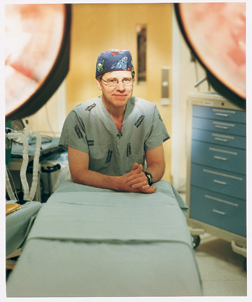More united than not
Leslie Williamson |
|
 |
|
By M.A. MALONE
Stanford anesthesiology professor Steven Shafer, MD, does not like to be in the spotlight. But as a member of the FDA advisory committee that in February reviewed Cox-2 selective painkillers’ safety, he couldn’t escape it.
Because of the potential health risks for millions, the media was stuck on this story like drosophilae on last week’s bananas. Every ounce of action by the committee was parsed, edited and presented to the public via a steady stream of news broadcasts, op-eds and media alerts from Web browsers. But one perspective wasn’t shared: the view from the panel.
Says Shafer: “One might think from the published stories that a sharply split committee narrowly endorsed the safety of Cox-2 selective analgesics, sending a green light to the pharmaceutical sponsors. But that wasn’t the case at all.”
In reality, says Shafer, the distinctions between committee members’ opinions bordered on the imperceptible. The members agreed unanimously that the painkillers pose an increased risk of cardiovascular events, he says. And they agreed that the drugs should have black box warnings.
It was a collegial group of nearly 40 scientists and clinicians, pulled from the FDA’s existing panels on anesthesia and life support, arthritis and drug safety. The seating assignments around a horseshoe-shaped table were designed to intermingle members from the different panels. For Shafer it was a key to the committee’s success.
“It prevented one side of the table from ganging up on another side,” says Shafer, who was seated at one end of the table. “Still, it was hard for the chair to run a meeting this big. He generally looked away from us, towards the cameras. So to get called on, those of us on our side had to flag him down like stranded motorists.”
Shafer says camaraderie developed over the course of the meetings. He kept his seatmates apprised of information gleaned from the Internet. “Seven minutes after the vote for Vioxx was narrowly approved, Yahoo! posted a headline that said ‘FDA Committee Endorses Use of Vioxx.’ ” How did Shafer know? He was the only committee member who was packing a wireless computer.
While some committee members might have thought he was checking e-mail, he was downloading journal articles under discussion. He also Googled patients and other interested parties as they addressed the committee, to sort out those who were legit from those who had ties to drug companies “or were just plain crackpots.”
Shafer cast the first vote on whether Vioxx should be allowed back on the market. When he cast it, he said, “No — but I would approve making Vioxx available to patients who really need it under some sort of compassionate use.”
After the meeting, he asked how his vote was counted: “no, with exceptions” or “yes, with restrictions”?
“Those positions are not very far apart. I think my colleagues on the committee all struggled, as I did, between ‘no, with exceptions’ and ‘yes, with restrictions’ in casting their votes.”
Though his vote was counted as a “no,” he’s glad the sale of Vioxx was approved, he says. “Our vote wasn’t a win for Merck, Pfizer or Novartis, and it wasn’t an endorsement of Vioxx, Celebrex or Bextra. Cox-2 selective analgesics will never again be marketed as safer alternatives to conventional non-steroidal analgesics. So the winner was the individual patient, who will continue to have therapeutic options and can make the most informed choice possible.”
Comments? Contact Stanford Medicine at

